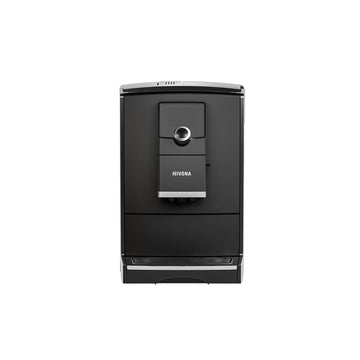NICR 790 CafeRomatica fully automatic espresso machine
-
Estimated Delivery:Dec 21 - Dec 25
-
Free Shipping : On All Products

NICR 790 CafeRomatica fully automatic espresso machine
The data sheet for the NICR 790 can be found here
Cappuccino so delicious, you want to press it.
The quality of a portafilter at the touch of a button. That's what we promise. Because our 7 series brings you this pleasure as conveniently as possible - even for a cup of cappuccino or latte macchiato.
Cappuccino at the touch of a button. Simple, fast and now in a new design. Because our 7 series is getting four new models. High-quality material meets aesthetics. For lovers of lattes and latte macchiato. In addition to the Aroma Balance System, the Cappuccino Connoisseur now also works in these fully automatic machines. For cappuccino like from the barista.
Features
|
Bean container size
|
For approx. 250 grams coffee beans |
|---|---|
|
Removable water tank (capacity)
|
2,2 Liter |
|
Design
|
Black |
Flavour
|
Adjustable coffee quantity
|
(approx. 20 ml – 240 ml) |
|---|---|
|
Adjustable coffee strength
|
In 5 levels |
|
Adjustable coffee temperature
|
In 3 levels |
|
Aroma Balance System
|
Available |
|
Cappuccino Connaisseur
|
Included |
|
Grinding degree
|
Adjustable |
|
Pre-brewing system
|
Available |
Comfort
|
2-cup function for espresso/coffee
|
available |
|---|---|
|
Hot water function for tea
|
For three temperatures |
|
Live programming
|
Available |
|
Powder compartment for a portion of ground coffee
|
Available |
|
Recipe factory settings
|
Modifiable |
|
SPUMATORE (for cappuccinos etc.)
|
OneTouch plus |
|
Saveable "My Coffee" recipes
|
5 Storage spaces |
Maintenance
|
Automatic descaling and cleaning
|
Included |
|---|---|
|
Brewing unit
|
Removable |
|
CLARIS fresh water filter
|
Included |
|
Control indicator for filter change
|
Available |
|
Rinse function for OneTouch SPUMATORE
|
Available |
Specifications
|
ECO mode
|
Available |
|---|---|
|
Max. power consumption
|
1455 Watt |
|
Pump pressure
|
Up to 15 bar |
|
TFT colour display
|
Available |
Technical Detail
|
Width
|
240 mm |
|---|---|
|
Height
|
340 mm |
|
Length
|
536 mm |
|
Weight
|
9.955 kg |

More Information For You
Things you need to know
Discover more in our FAQ
Do you ship internationally?
No, we currently ship only within India.
What are the different brands of coffee machines that are available on coffeeworkz?
Bialetti, Melitta, Ariete, and Nivona as available brands.
Does Coffeeworkz source its machines from top brands?
Yes, we offer machines from well-known and trusted brands in the coffee industry, ensuring top quality and reliability.
Does the company offer a hassle-free return policy?
Yes, Coffeeworkz offers a hassle-free return policy for your convenience.
What types of coffee machines are available on Coffeeworkz?
Coffeeworkz offers a range of coffee machines from top brands like Bialetti, Melitta, Ariete, and Nivona, catering to different brewing preferences and needs.
Is it normal for some water to collect in the drip tray after making coffee?
Yes, that’s normal. The machine releases leftover water and pressure into the drip tray after each use.
How can I adjust the coffee strength?
You can choose between mild, normal, or strong coffee at the touch of a button — this changes the coffee quantity per cup (7–11 g). For stronger flavor, use a finer grind; for milder coffee, set the grind coarser. (Adjust grind size only while the grinder is running.)
My coffee tastes weak.
You can adjust the strength by selecting mild, normal, or strong at the touch of a button — this changes the coffee quantity per cup (7–11 g). For a stronger flavor, use a finer grind; for a milder taste, use a coarser grind. (Adjust the grind size only while the grinder is running.)































